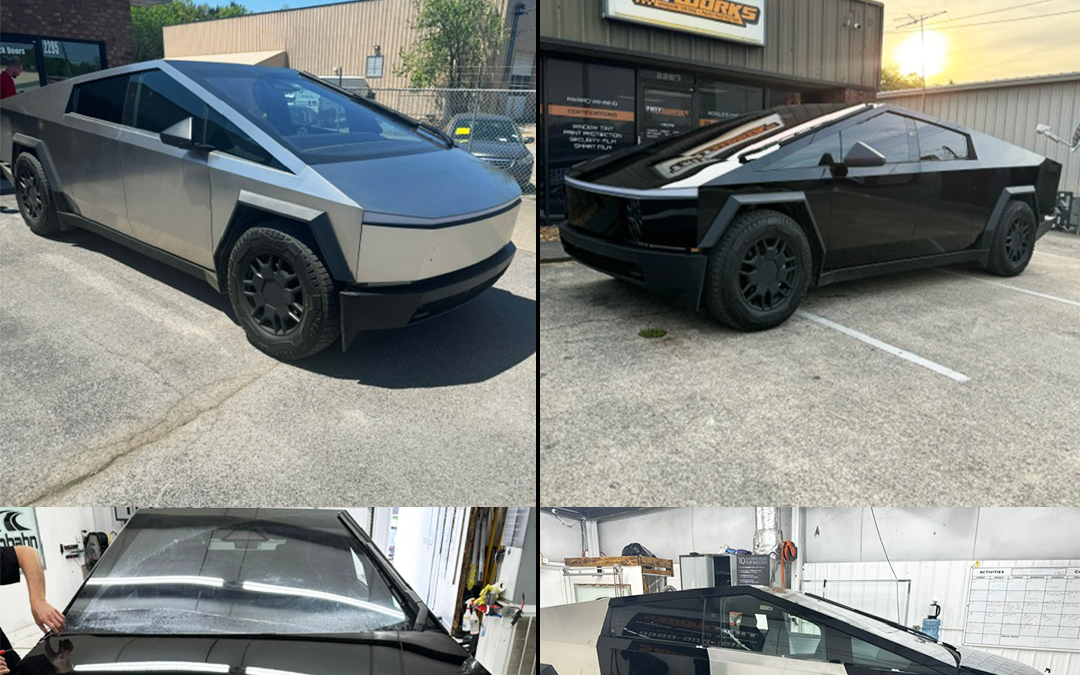Tesla’s 6,000-plus pound, stainless-steel Cybertruck is one of the hottest vehicles in 2024. A recent Motor1.com article reported that Tesla has already delivered more trucks than the total number of Hummer EVs sold in 2023. In just four months.
A Trio of Solutions
The vehicles are so popular that consumers willingly pay more than the manufacturer’s suggested retail price (MSRP). The 2024 Tesla Cybertruck starts at $81,895 and goes up to $101,985, based on the various trims and options.
“We worked with a customer who bought a Cybertruck on Facebook Marketplace from a private seller,” says Randy Humphries, Owner of Tint Works in Murfreesboro, Tenn. “He wanted this truck because he knew it was different. He told me this was his ‘forever’ truck.”
Humphries and two other installers—Eric Witt and Chris Marlin—took the truck’s look to new heights with Hexis BFBLACK Gloss Black PPF by way of Mike Watson at TBL Distributors LLC; Autobahn Ceramic i3 Window Film; and a Gtechniq ceramic coating. The extensive project spanned three days and generated a $11,000 ticket.
“We changed the entire look,” Humphries says. “This project is at the top of my all-time list. This is by far the most unique and memorable transformation.”
Disassembly Points
Before installing Hexis’ colored PPF, Humphries and his crew disassembled several components of the Cybertruck: window channels, mirrors, and fender flares. Humphries called his good friend John Scott, Owner of Scott Solar Auto Spa in Arlington, Texas, for guidance.
“There’s a plastic cap on the inside of the doors,” Humphries says of the mirror disassembly process. “Before you take the mirror out, pop the plastic cap. Unplug the plug inside. Next, pull back the rubber flap where the mirror is. You pull that back and there are three T40 Torx Screws. Take those out, and pick the mirrors straight up.”
Protecting a Cybertruck
The colored PPF gave the stainless-steel truck an entirely new look, providing protection against future road hazards.
“The only way to protect a stainless-steel vehicle is by putting some type of film on it,” Humphries adds. “Otherwise, it’ll be a nightmare to keep clean. You know what I mean if you have kids and stainless-steel appliances. It’s a refrigerator on wheels. Before the installation, I recommend prepping the car with denatured alcohol and a clay bar.”
Overall, Humphries says the PPF portion of the project wasn’t too challenging.
“The trick is to get your soap mixture right,” Humphries says. “We used Core Film Installation Software [Eastman Performance Films]—the patterns were spot on. We started in areas that weren’t overlapping each other. We started from the top of the vehicle and worked our way down so that we would not spray water onto an already-drying area.”
Humphries adds, “The cybertruck has very tight and sharp edges. Many of the panels press against each other. For me, it wasn’t just one fluid installation. I had to do it in sections, with different types of passes to make sure everything was set properly.”
Pricing the PPF Portion
“If you’re doing PPF and wrapping the edges, if it’s not between $6,000 or $7,000, it’s not worth the time,” Humphries says. “It doesn’t matter how difficult an installation is. You have to look at the potential cost of replacing damaged parts and components. If you’re doing a car for $3,500 and damage something that’s $4,000 to replace, you’re in the red.”
Tinting a Cybertruck
“To me, tinting the windshield was by far the hardest part of the installation,” Humphries shares. “The windshield is bigger than the Model X’s. It’s easier to heat shrink. But the dash is so deep; you have to get in there without damaging the screen. It’s a lot of work to get that film in place.”
Featuring a multi-layer ceramic construction, Autobahn Ceramic i3 Window Film provides heat rejection, UV protection, and glare reduction.
Closing Thoughts
“The client was stoked,” Humphries says. “Knowing the customer is happy makes me feel good. He just dropped off his Range Rover, and took a bunch of business cards.”

